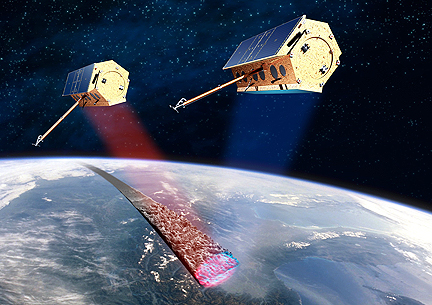 On October 14, 2010, the radar satellite TanDEM-X moved into close formation with its 'twin', TerraSAR-X. Before this, the two satellites were orbiting 20 kilometres apart — a flight time of almost three seconds. Now, there are only 350 metres separating the pair, which means their antennas are able to acquire radar images of the same area simultaneously. The objective of the mission is to create a high-precision, three-dimensional digital elevation model of Earth's land surface. The project needs the satellites to operate in parallel for a period of three years. The transition to close formation flight marks the beginning of the final preparatory stage of the TanDEM-X mission. The routine operations phase is due to start in early January next year.
On October 14, 2010, the radar satellite TanDEM-X moved into close formation with its 'twin', TerraSAR-X. Before this, the two satellites were orbiting 20 kilometres apart — a flight time of almost three seconds. Now, there are only 350 metres separating the pair, which means their antennas are able to acquire radar images of the same area simultaneously. The objective of the mission is to create a high-precision, three-dimensional digital elevation model of Earth's land surface. The project needs the satellites to operate in parallel for a period of three years. The transition to close formation flight marks the beginning of the final preparatory stage of the TanDEM-X mission. The routine operations phase is due to start in early January next year.
The close formation flight marks the bistatic phase of the TanDEM-X mission. The two radar satellites no longer work independently, but in synchronisation. One satellite transmits the radar signals needed for image acquisition, but then both satellites receive the signals reflected from the ground. Working in close formation, TerraSAR-X and TanDEM-X's antennas complement one another like a pair of eyes. The combination of both radar images will no longer suffer from temporal changes between subsequent acquisitions over water or forest areas, and the combined sets of data can be processed into high-quality elevation models. There are also energy-related benefits to this recording method. Because of the power consumption and build-up of heat, a radar satellite has a limit to the length of time for which it can transmit. However, in bistatic mode, TerraSAR-X and TanDEM-X share the transmission task. This means that the DLR scientists can use double the acquisition time that is available with one satellite.

